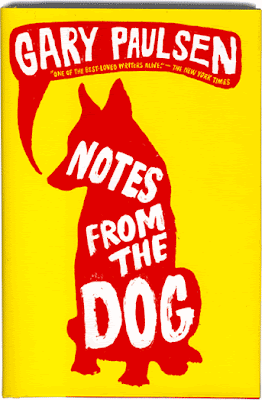
"And before it was all over, we saw just one more thing: a man dancing with his wife at the water's edge to music only they could hear. He put a hand where her right breast had been as he bent to kiss her. Johanna was behind us at that moment, bundled in a huge sweatshirt. She slipped behind me and Matthew, putting her arms around us and pulling us tight. "Cancer can't ever touch that."
-Notes From The Dog
Hopefully this excerpt displays the power of this novel effectively. Gary Paulsen's Notes From The Dog is a perfect example of young adult literature that is very engaging, but also covers a depressing subject (Cancer) in an extremely powerful way. The main character Finn (Huckleberry reference!) is somewhat of an outsider who is disengaged with the world. He is a reader of many books, and lives withing his own boundaries as he opens the novel with the immortal line: "Sometimes having company is not all it's cracked up to be". This type of character is very popular in these type of books, perhaps because young readers can easily relate to an individual who is somewhat guarded. For most of us, the whole high school experience involved us having to protect ourselves from the individuals around us, not because they were all bad, simply that the teenage years are the ones where we are most likely to feel vulnerable to the world and all of it's complexities.
I loved this book. The simplicity, use of emotion, strong characters, topicality, and general accessibility (a mere 129 pages) stood out above all the other books I have blogged on this month. Paulsen is something of a legend in the YAL world, and his ability to connect to younger audiences is something I greatly admired.
Johanna (Finn's neighbour, a breast cancer sufferer) fits many of the archetypal female characteristics of other YAL literature. She is sociable, active, very much a go-getter in life. But what sets her apart from other female characters in the genre is her disease. As she is a cancer breast sufferer, it is easy to sympathise with her and understand the emotional turmoil that she must be going through. Paulsen creates a character filled with optimism, and for me she was the highlight of this book. Finn himself I could definitely relate to. His introverted behaviour was easy for me to connect to, and I also loved Dylan (his dog) who was thoroughly involved in the story and helped create some of the humorous situations that occured.
I would say this novel is an essential read for future teachers, and it would also be very easy to bring into the classroom. Many kids will relate to the themes and topics here, and it deals with a very weighty subject in a very touching and engaging way.
Blogged by Stuart Millar

